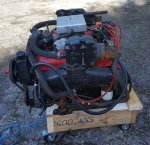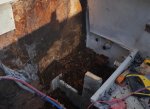sogood
Petty Officer 1st Class
- Joined
- May 11, 2016
- Messages
- 361


So, further to the above, I finally got the gimbal housing off and had a better look at what was going on inside. While my bellows, on first inspection seemed to be in one piece, with no cracks or damage, the same can't be said of the housing.You can see from the photos, that both the "retaining ring" in front of the bearing has a chunk missing out of it along it's bottom edge. Likewise with the bellows "flange. As the bellows clamps onto both of these parts, it was only a matter of time before it sprang a leak, especially as the leg has to stay raised when the boat is moored, putting extra tension on the bellows in these exact spots.
So, I'm curious to know if the "retaining ring" ( forgive the terminology) is removable/replaceable and if so, is it a push fit or does it screw in. I'll be replacing the bearing also, for what it's worth. Likewise with the flange on the gimbal. The damage doesn't look repairable, so does this mean replacing the whole gimbal housing? Not pretty, but happy to get to the bottom of my leak and not to the bottom of my harbour!
Any thoughts or input much appreciated.

























